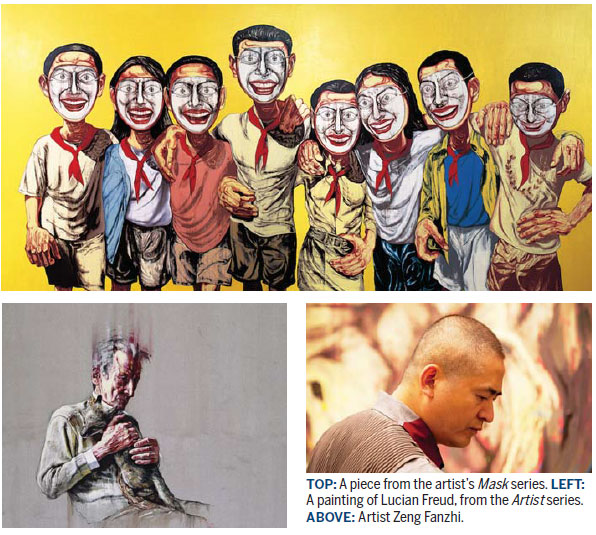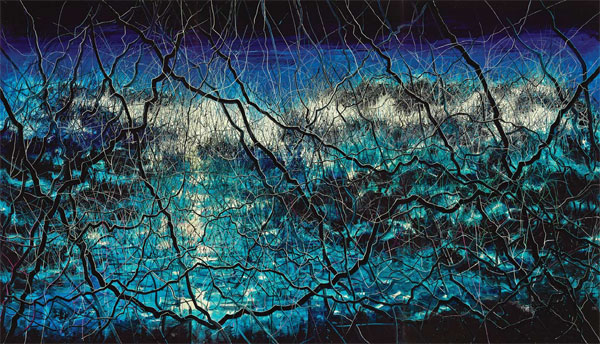A look behind the mask

Viewers see another side of top-selling painter Zeng Fanzhi in his largest solo exhibition
Zeng Fanzhi is tired of being associated with only his Mask series, which commands eight-figure sums at auction. So now he's holding an exhibition in Beijing to showcase his other work.
"I hate to be stereotyped," the painter says. "It's time for ordinary people to get access to my real work. They will find that the Mask series is a tiny part of my creations."
| Zeng Fanzhi's Blue, oil on canvas, a piece from the Chaos series. Photos Provided to China Daily |
Zeng, 52, is one of the world's best-selling artists. His work The Last Supper, part of the Mask series, sold for $23.3 million (20.8 million euros) in 2013. "I was happy at first, but then I got stressed. An artist can't be in ecstasy or in tension for too long. So I dealt with the chaos, or else I wouldn't be able to create anything."
An artist has to be free and absolutely honest in his creations, he says. "Many collectors wanted to commission my paintings. Even my father hoped I would paint more in the series. But being commissioned is ridiculous and disastrous for an artist."
Critics say early pieces like The Hospital series and The Meat series are a lament on cruelty and the fragility of life, but Zeng says he only picks up his brush when he is really touched, and that it's entirely instinctive.
He completed these earlier series while still a senior at the Hubei Institute of Fine Arts in Wuhan. "It was sensational to paint this bloody stuff, but it wasn't acceptable as graduation work. At first, I handed in a draft sketch of Tibetan scenery, as my tutor required, but I fooled him in the end by later handing in The Hospital Triptych."
Zeng, who is taciturn and has a romantic and rebellious streak, says Wuhan, the city he grew up in, provided the inspiration for his early works.
"I lived close to a meat-processing plant as well as a hospital where I'd go to use the washroom every day. Those familiar scenes triggered my desire to paint."
His ongoing exhibition, Parcours, which comprises more than 60 works, is Zeng's largest solo exhibition to date. It opened at the Ullens Center for Contemporary Art in Beijing on Sept 19 and will run until Nov 19.
Japanese architect Tadao Ando, who designed the exhibition, says. "I came up with an idea where the audience can feel the in-depth world of the artist's creation if they see the artwork through a series of windows cut out of several parallel walls."
One of the pieces seen through a window is a self-portrait. In the painting, Zeng is in a red Buddhist robe, barefoot, sitting on a stool.
"That's not a cigarette in my hands, it's a pen, with a line winding in the air," the artists says. "This self-portrait accurately describes my state of mind at that time, tranquil and detached. I think I'm doing well in protecting my territory."
Anyone who has visited the painter's studio will understand why he is not disturbed by the chaos outside. Zeng, who uses gardening as a form of meditation, often paints while listening to his favorite classical music, such as Tchaikovsky or Smetana.
In addition to oil paintings, there's also a dark and mysterious room in the exhibition. This is for Zeng's Paper series, an experimental work that he started in 2009. It is first time the series, inspired by a piece of handmade paper, has gone on public display.
"The paper does 30 percent of the painting. I paint 30 percent. The rest is done by each viewer," he says.
Basically, one does not need to understand the theory of art to appreciate a painting. However, if one understands both Western and traditional Eastern art, especially paintings from the Song Dynasty (960-1279), one can enjoy Zeng's works on paper even more.
"Even if you don't know art history, art can be rewarding if you are patient. You have to communicate with the work, stare at it for a while and feel it. Just a quick glance will leave you disappointed."
That's why he ensured that the exhibition room is dark, and it takes as long as a minute for the viewer's eyes to adapt to the environment.
Zeng also believes that a calm mind is important to enjoying art. "Only when one is calm, can one notice subtlety."
He has not given up on oil painting, however. He returns to it from time to time. "I have to be absent for a while, or else I'll become too obsessed and blind."
Speaking of his regrets, he says he once drew a portrait of Lucian Freud, one of Britain's greatest artists, and was just about to send it to him when he learned that the artist had died.
As for his other works, there is also the Chaos series. Zeng held two brushes with his right hand and painted alternately - one sketches, the other disturbs the painting. This, he says, created an unexpectedly interesting effect.
"Order is meant to be broken and established. So when the new order becomes a shackle, it has to be broken again."
xiaoxiangyi@chinadaily.com.cn

(China Daily Africa Weekly 09/30/2016 page21)
Today's Top News
- US plan for arms sales to Taiwan condemned
- China creates 12.1m new urban jobs
- Dialogue constructive way to rebalance trade
- AI needs to be governed wisely to ensure that it is beneficial for future of humanity: China Daily editorial
- China warns about Japan's intended military buildup
- China urges EU to halt anti-subsidy probes































